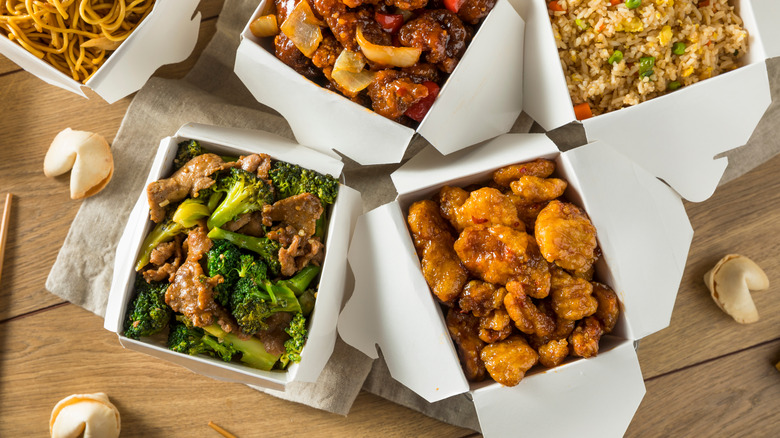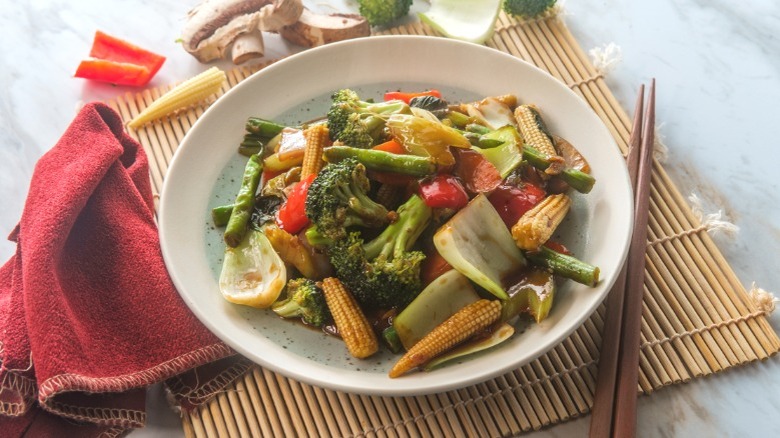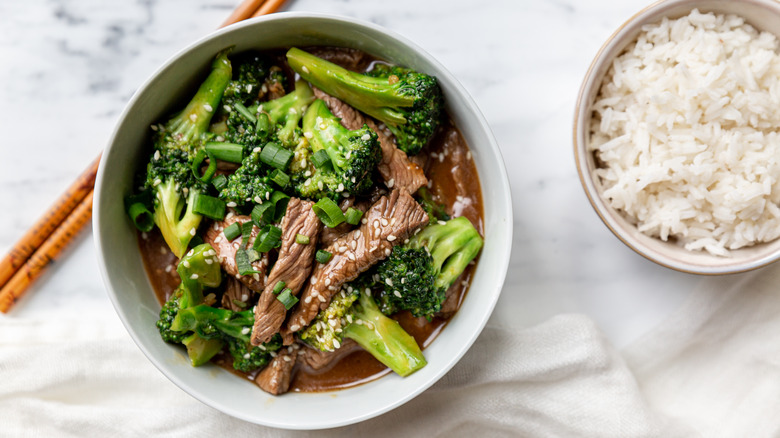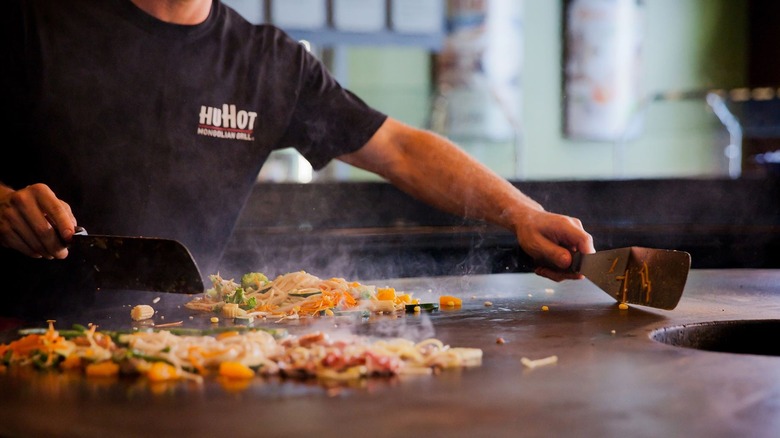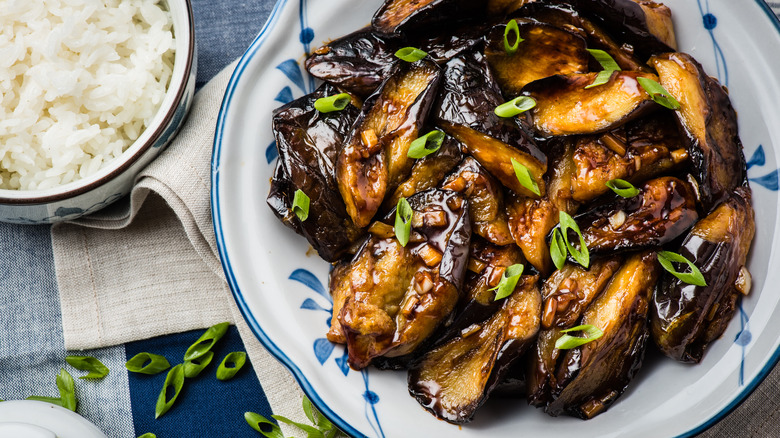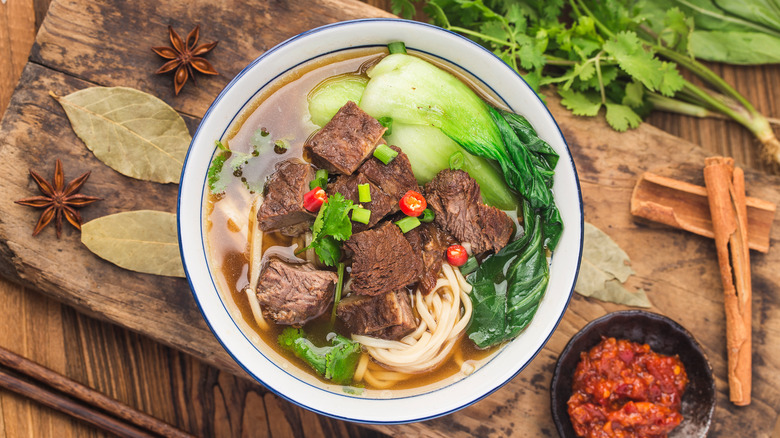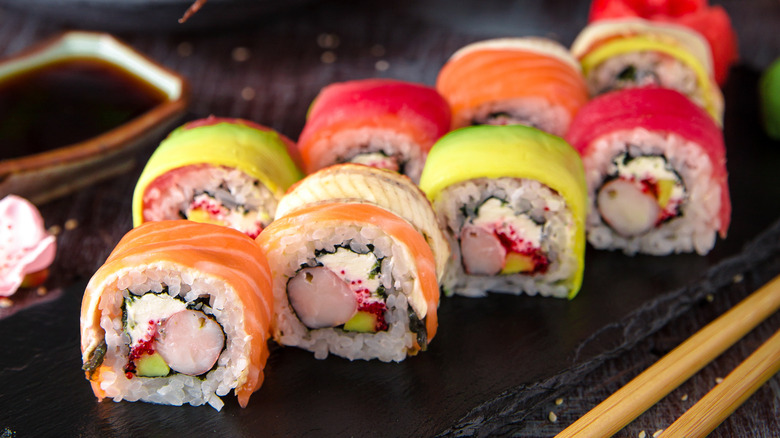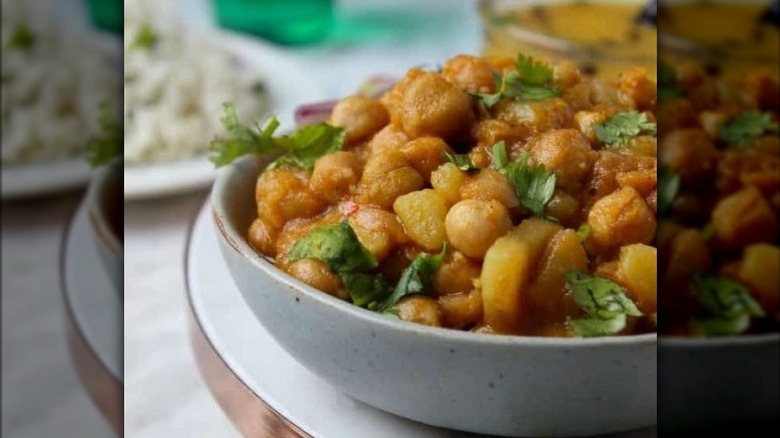The 13 Healthiest East Asian Takeout Meals
Are you craving East Asian takeout? Takeaway and delivery services are more accessible than ever. So if you're not in the mood to cook, no worries. You can order East Asian cuisine in minutes without ever setting foot in the kitchen — or sitting down at a restaurant.
So what's the downside to ordering takeout? For one, restaurant food isn't always considered as healthy as homecooked meals. A study in the International Journal of Behavioral Nutrition and Physical Activity examined the health benefits of cooking at home. Results showed that the more often people ate homemade meals, the more fruits and veggies they consumed. Not only did they have higher vitamin C levels, but they also had a healthier body mass index and body fat percentage.
So does this mean that takeout is unhealthy? Absolutely not. Many East Asian dishes are both flavorful AND nutritious. There are plenty of healthy options that rival homecooked food. So if you're looking to order East Asian cuisine but maintain a healthy lifestyle, keep reading for the best takeout meals on the menu.
Teppanyaki
Teppanyaki refers to a style of cooking, not an actual dish. The term teppanyaki stems from the Japanese words for "iron plate" and "grilled," which is precisely how these meals are prepared. Oil is spread on the flat-iron griddle, then topped with various ingredients, including sliced meats, seafood, veggies, and noodles. The dish is often made-to-order, and guests can mix and match depending on their preferences.
The way teppanyaki is prepared is healthier than most takeout options. Instead of being fried in copious amounts of oil, the food is sautéed using a smaller portion. Teppanyaki chefs sometimes use teriyaki or other sugary sauces. However, you can choose soy sauce for fewer calories or go sauceless if you're avoiding extra sodium or sugar altogether.
Watching teppanyaki chefs is truly a sight to behold. They're skilled at their craft and put on quite the performance. As such, you might not realize teppanyaki can also be a takeout dish. Unfortunately, you'll miss the show — but the meal will be delicious (and nutritious) regardless.
Bibimbap
Bibimbap is a Korean rice bowl with kimchi, veggies, and meat in gochujang (Korean red pepper paste). If you add an egg, you'll get even more for benefits; they're nutrient-dense and a complete source of protein. When the dish arrives, the ingredients are slightly separated, and it's up to you to mix them all together. Break the egg yolk and distribute the gochujang so that every bite has just the right amount of sauce and spice.
This rice bowl has a healthy balance of macronutrients and a solid array of vegetables. Traditional bibimbap comes with marinated beef, spinach, and bean sprouts. If you want a lighter dish, opt for hweodopbap, which has a couple different spellings. This summery version of bibimbap swaps meat for fish and replaces some veggies with crunchy cucumbers.
Bibimbap is nutritious but still gives fast food a run for its money. After eating junk food, we might feel a tad guilty, but we're also filled with a gratifying sensation. When we eat comforting foods, we get a rush of dopamine — which keeps us coming back for more. The good news is that bibimbap provides that same comfort-food feeling with more of what's healthy for you.
Goma Wakame
Goma wakame, aka seaweed salad, is a common starter in Japanese restaurants. This salad is served cold or at room temperature and sprinkled with sesame seeds. It's refreshing and light on the palate but oh-so-satisfying.
And luckily, seaweed salad is also one of the most nutrient-dense foods you can eat. It's very low in calories, with 2 tablespoons of wakame ringing in at a mere 4.5 calories. However, it's packed with trace minerals. According to a study in Critical Reviews in Food Science and Nutrition, seaweed has a mineral content of at least 10 times that of land-based plants. Many of these minerals are also essential, meaning we must get them from food because our bodies can't produce them. These trace minerals keep everything from our endocrine system to our nervous system ticking, and seaweed is an efficient way to get your daily dose.
Seaweed's biggest claim to fame is its iodine content. This trace mineral occurs naturally in seaweed and helps regulate thyroid function. Not consuming enough iodine can lead to hypothyroidism, and, according to the American Thyroid Association, almost a third of the world is at risk of deficiency. Even without a deficiency, low thyroid function is no fun, leading to moodiness, fatigue, and brain fog. So if you suspect low iodine and want to boost your levels, seaweed makes an excellent takeaway meal.
Salmon Sashimi
Sashimi is all about simple, quality ingredients. Good salmon sashimi has a subtle flavor and a buttery texture that melts in your mouth. Dipping it in soy sauce gives it that umami saltiness, while wasabi adds a strong kick, hitting your sinuses just as much as your taste buds.
Flavor aside, salmon sashimi fills a much-needed gap in American diets. Macronutrients — carbs, protein, and fat — each serve a purpose. But unfortunately, the standard American diet is heavily skewed toward carbs and lacks protein and unsaturated fats. Luckily, a 3-ounce serving of raw salmon contains 17 grams of protein and 11 grams of fat, with a healthy dose of omega-3s. It's also one of the few foods that's naturally carb-free.
So why are macronutrients so important? For one, macronutrient balance plays a big part in blood sugar regulation. When we eat carbohydrates (especially sugar-laden ones), our blood sugar spikes and then falls. This isn't inherently bad, but when you eat too many too frequently, your body becomes stressed. Over time, your ability to keep your blood sugar in a healthy range deteriorates, leading to many other health issues. However, protein and fat don't raise blood sugar nearly as much. In fact, when eaten alongside carbs, they have a stabilizing effect. So if you want off the sugar-driven roller coaster, enjoy some salmon sashimi for your next takeout meal.
Buddha's Delight
Variety is the spice of life, and Buddha's delight certainly keeps things exciting. In its unabridged form, Buddha's delight has a whopping 18 different vegetables. Common contenders are carrots, snow peas, cabbage, bok choy, and broccoli. All the veggies are sautéed in a light dressing made of sesame oil, soy sauce, garlic, and ginger.
Rumor has it this dish started in Buddhist communities but spread throughout China and, subsequently, the world. Buddhists traditionally eat a vegetarian diet, which explains why this dish is entirely plant-based. Chinese communities also consume Buddha's delight during the Lunar New Year celebrations since eating vegetables is said to bring good luck and purify the soul. Seeing how these holidays involve grand feasts, veggies can also help with digestive issues. Vegetables are a good source of fiber, so they help you absorb nutrients and keep that digestion moving.
Plus, the more color you add to your diet, the more likely you are to get all the nutrients you require. So if you want to "eat the rainbow," look no further than Buddha's delight.
Chinese Beef and Broccoli
In Chinese beef and broccoli, strips of marinated flank steak and crunchy broccoli florets are sautéed together in a rich brown sauce. The main ingredients are simple, but the sauce really packs a punch. Soy sauce, oyster sauce, rice wine, garlic, and a dash of sugar are combined into a thick broth that permeates the meat and vegetables so that each bite is full of succulent flavor.
The two main ingredients are in the dish's name — and both are nutritional powerhouses. Beef is an excellent source of B vitamins, zinc, and selenium. Zinc is crucial for the immune system and helps your body generate new cells and repair damaged tissue. Broccoli is in the family of cruciferous vegetables, which can help prevent cancer and have anti-inflammatory properties.
Together, beef and broccoli are teeming with fiber and protein. So if you're craving a healthy yet satisfying stir fry, Chinese beef and broccoli is the way to go.
Korean Lunch Box
Do you miss the days of packed lunches? Korean lunch boxes are the perfect replacement. But instead of your parents prepping it, you'll need to pick one up at a local Korean restaurant.
Korean lunch boxes, also called dosirak, consist of rice, a protein, a side dish, and pickled veggies. Koreans love fermented foods, particularly kimchi, which is made of fermented cabbage with a pepper paste and a hefty dose of garlic. The result is a pungent, spicy side dish that works wonders for your digestive system. In a 2021 study published in Cell, participants who consumed fermented foods increased their microbiome diversity and decreased their inflammation markers. So if the road to health is paved with good intestines, kimchi can get you one step closer.
These takeaway lunches are ideal for busy workdays or picnics. Sadly, they won't come in tin cases decorated with your favorite comic-book characters. But what you can expect is a healthy, convenient, and tasty takeaway meal.
Mongolian BBQ Stir Fry
Eating at a Mongolian restaurant is a very hands-on experience. You create your own meal by grabbing a large bowl and selecting from a raw buffet of goodies. The lineup includes noodles, protein, veggies, and sauces. Once your bowl is piled high, a chef will fry up your creation right before your eyes. The whole thing happens in a matter of minutes, at which point you can request takeout and be on your way.
Here is the tricky part: You're responsible for choosing your ingredients. So be intentional and practice some self-control. Ultimately, Mongolian stir fry can be as healthy or unhealthy as you'd like. Portion sizes also come into play. Prices are by the bowl, so you might be tempted to pile several meals worth onto one plate. If you can't resist this urge, stock up on veggies or enjoy that stir fry over a couple of days.
This style of takeaway gives you flexibility. You can make your meal vegetarian, gluten-free, low-carb, or low-fat ... you get the idea. But remember, the grill is shared by all, so if you have any strict dietary restrictions, let the chef know beforehand.
Chinese Eggplant with Garlic Sauce
If you love your health, you should learn to love your vegetables — and this Chinese dish is easy to fall for. Eggplant has a naturally meaty texture that gives this meal substance. When cooked in a savory garlic sauce, the result is a smoky, hearty stir fry that can support your gut health.
The human body contains trillions of microorganisms, and it's constantly trying to balance the good with the bad. The food you eat either helps or hinders this process. Vegetables play for the good team, while sugary or processed foods tend to bat for the baddies. And without enough veggies, the bad guys often come out on top. When this happens, we might experience digestive issues, a poor immune system, or fatigue.
Luckily, certain foods are known to bring your microbiome back into equilibrium. And throughout history, garlic has been one such superfood. It's revered as a natural antimicrobial that can be applied to a wide variety of harmful bacteria, fungi, and viruses. It was even considered one of the first performance-enhancing drugs used by athletes in the ancient Olympics. So if you want to enhance your overall health, include more garlic in your diet. And with this delicious takeout meal, it won't be difficult.
Kimbap
Kimbab has seasoned veggies and meat wrapped in rice and encased in dried seaweed strips. Like a sandwich or burrito, it's an easy meal to toss in your bag and eat on the go. With the primary ingredient being rice, kimbap is energy-dense, so it's perfect for those busy days, whether they're spent exercising, running errands, or working at the office.
Broken down, kim means seaweed, and bap means rice. To be true kimbap, it must contain these two ingredients — but the fillings can vary. You can find meat-heavy versions or vegetarian options to suit your dietary needs. And nowadays, it's becoming increasingly common to find gluten-free kimbap as well. But if one thing is for sure, it's that your kimbap will come wrapped in dried seaweed, which can do wonders for your health.
According to a 2009 study in the Asia Pacific Journal of Clinical Nutrition, metabolic syndrome is increasing in most countries, except those that consume significant amounts of seaweed. Metabolic syndrome is a group of conditions, such as high blood pressure, high cholesterol, and excess body fat, that negatively affect your health. However, seaweed can support your thyroid, which ultimately boosts your metabolism and immune system.
Taiwanese Beef Noodle Soup
As one of Taiwan's national dishes, this soup has beef, noodles, and bok choy in a richly seasoned sauce. Bok choy is native to China and common in East Asian dishes. However, this vegetable doesn't get the love it deserves here in the United States. Unlike more divisive cruciferous veggies like broccoli or Brussels sprouts, bok choy has a mild taste and soft texture, and most people enjoy these greens.
When ordering takeout, you can enjoy bok choy's yummy flavor along with its many nutritional benefits. One cup of bok choy has over 31 milligrams of vitamin C, roughly a third of the recommended daily amount. It's also a significant source of folate, beta-carotene, and selenium. Vitamin C and folate are water-soluble, and a high percentage of these are normally lost in the cooking process. But in Taiwanese beef noodle soup, the bok choy is cooked directly in the broth. This way, all the vitamins (and the flavor) stay in the soup.
Beef noodle soup is a standard takeout meal in Taiwan, but it's only recently becoming popular in the United States. So if you stumble across it on a menu, don't hesitate to place that order. It's sure to be an international sensation soon.
Sushi Rolls
Sushi rolls tick a lot of health boxes. They have complex carbs, veggies, and protein all rolled into one meal. And although many different sushi rolls are considered healthy, let's hone in on some of the most nutritious — those with raw fish.
While raw fish isn't for everyone, it's actually one of the best ways to consume fatty fish. Fatty fish like salmon is an excellent source of omega-3s, which can lower inflammation, balance hormones, and protect your heart. You've probably already heard these fun facts, but you might not know that these precious omega-3s are quite delicate. At high temperatures, these fatty acids break down. As such, you're better off getting your omega-3s from raw fish than cooked.
Because of the many health benefits of fish, the American Heart Association now recommends eating at least two servings per week. Ordering takeout is a stress-free way to reach this quota. And we'd recommend going for rainbow or avocado salmon rolls to get as many omega-3s as possible.
Tibetan Potato and Chickpea Curry
You won't find Tibetan restaurants on every street corner. But if you have one near you, many healthy options are on the menu. One such dish is the potato chickpea curry. This comforting stew can be eaten at any meal accompanied by rice or bread.
Tibetan food is healthy because the cuisine uses fresh, natural ingredients. What you see is what you get with this curry. Aside from potatoes and chickpeas, the dish has tomatoes, onion, turmeric, and cumin. Tibetans traditionally use yak butter when cooking, but ghee is a common replacement in the United States. Ghee is essentially clarified butter, making it safe for lactose-intolerant individuals. While other oils oxidize when cooked, ghee can handle high heat while retaining its nutritional properties. It's a rich source of vitamins A, E, and K, along with butyric acid (which is excellent for digestion and staying regular).
With fiber-rich chickpeas, this meal is also super satiating. So if you want to try something new but healthy, order this Tibetan curry for takeaway.
